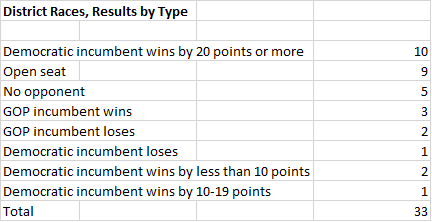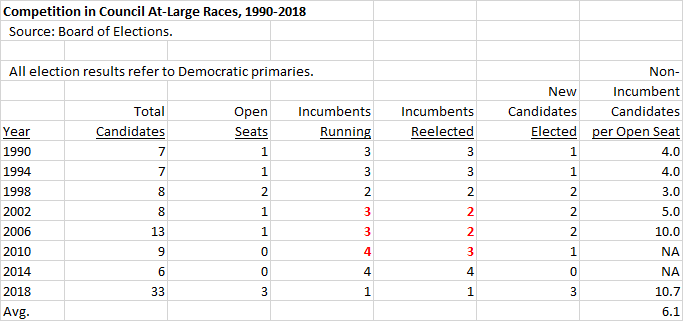By Adam Pagnucco.
Since 1990, the Montgomery County Council has had five district seats and four at-large seats. Every few years, proposals are made to get rid of the at-large seats and go to an all-district seat system. County voters rejected a ballot question doing so in 2004 by a 61-39% vote. The county is fortunate that they did because getting rid of the at-large seats is a terrible idea.
Why is that so?
The table below shows the outcome of council district races over the last six cycles, plus open seat special elections in 2002, 2008 and 2009.

Here is the distribution of outcomes in these contests.

The huge majority of these races are non-competitive when Democratic incumbents are on the ballot. In fact, a Democratic district incumbent has not been defeated since 1998, when challenger Phil Andrews door-knocked his way to victory against District 3 incumbent Bill Hanna. Since then, a challenger to a district incumbent has come within 10 points only twice. Democratic district incumbents have an 18-1 win-loss record since 1998, which includes 5 races with no opponent. In the last 10 races with district incumbents, the incumbents have won by 40 points or more 8 times.
Now let’s look at at-large council races since 1990.

There are four at-large council seats. In every cycle since the current system was instituted, there has been more than four at-large candidates, meaning there has always been competition. That has been true even in cycles in which all four incumbents were running (2010 and 2014). In three cycles (2002, 2006 and 2010), an incumbent was defeated. In 2018, an incredible 33 Democrats ran at-large when 3 open seats were available.
Public financing no doubt played a role in encouraging so many candidates to run at-large. In contrast, district races with incumbents in 2018 were sleepy aside from District 3, in which the incumbent used public financing and the challenger stayed in the traditional system. (The incumbent won.)
All of the above illustrates a central fact: at-large races with incumbents usually have much more competition than district races with incumbents. One reason for that is the nature of such elections. An at-large race is a beauty contest with the four most popular candidates winning. Negative campaigning is uncommon except when slates are present (as in 2002). But in a district race with an incumbent, a challenger must make the case that the incumbent has committed a firing offense; otherwise, voters tend to go with the incumbent. Most candidates stay clear of heavy-lifting negative campaigns, especially when they are likely to lose, and with rare exceptions (like 2018 District 3 challenger Ben Shnider) the best ones prefer to run at-large.
Political competition is precious. Decades of evidence from our elections shows that abolishing at-large council seats would destroy most political competition in council elections. That is a really bad idea.
That said, supporters of adding districts are not wrong. More on that tomorrow.
